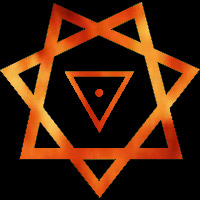
Babalon Shrines
Holy Days
Shrines List
Shrine Guidelines
Shrine Council
Shrine Application
Mystery Babalon
Updates
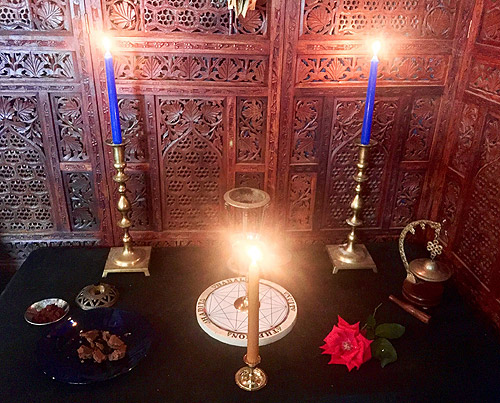
The Holy Days and Feasts
The Holy Days of Babalon
The High Holy Days of Thelema
The Feasts of the Times
The Feast of the Evening Star
Current Calendar
January 26: Babalon’s Day of the Moon – Underworld Rebirth
February 2: Imbolc Fire Festival
March 20: Babalon’s Day of Mercury – Gate of the God
March 20: Equinox of the Gods, New Year’s Day
March 20-April 10: High Holy Days
April 31: Beltane Fire Festival
May 11: Babalon’s Day of Venus – Seduction and Conception
June 21: Litha – Summer Solstice
July 2: Babalon’s Day of the Sun – Ecstasy of Life
August 1: Lammas Fire Festival
August 23: Babalon’s High Holy Day of Mars – Will Triumphant
September 22: Mabon – Fall Equinox
October 14: Babalon’s Day of Jupiter – Bounty of Fortune
October 31: Samhain Fire Festival
December 5: Babalon’s Day of Saturn – Transformation of Death
December 21: Yule – Winter Solstice
The Holy Days of Babalon
(Taken with kind permission from Mystery Babalon II: The Rites of Life, Seasons and Times)
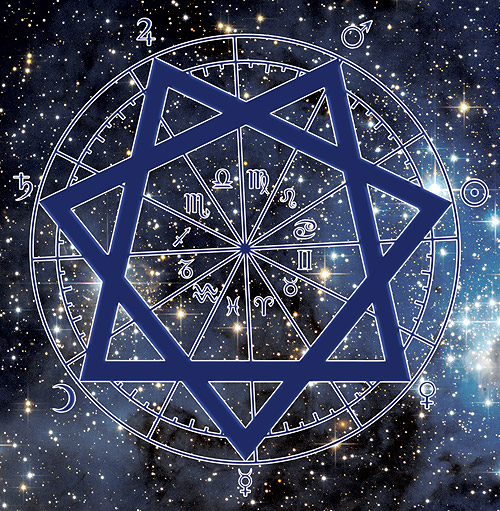 The secret Holy Days of Babalon were first divulged to the world in Anno 113 (August of 2017 e.v.) via the Shrines of Babalon system which was world-wide at that time. The celebration of Her Holy Days began on August 23rd of that year, the Day of the Daughter of Fortitude, followed by six other Holy Days spread across the Wheel of the Year according to a special formula. As will be shown, these Holy Days synchronize with the Solstices and Equinoxes via the Spring Equinox, and perfectly compliment the story of the Sun and Gaia through the Eight Sabbats as shown on the traditional Wheel of the Year.
The secret Holy Days of Babalon were first divulged to the world in Anno 113 (August of 2017 e.v.) via the Shrines of Babalon system which was world-wide at that time. The celebration of Her Holy Days began on August 23rd of that year, the Day of the Daughter of Fortitude, followed by six other Holy Days spread across the Wheel of the Year according to a special formula. As will be shown, these Holy Days synchronize with the Solstices and Equinoxes via the Spring Equinox, and perfectly compliment the story of the Sun and Gaia through the Eight Sabbats as shown on the traditional Wheel of the Year.The Formula of the Holy Days
In Greek, the word Babalon (Βαβαλον) has the value of 156. (2 + 1 + 2 + 1 + 30 +70 + 50 = 156.) The Formula of the Holy Days is based upon this exoteric number of Babalon. She is also the Lady of Seven Sevens, as can be shown by the mathematical formula which employs that exact number of sevens, 77 + (7 + 7) / 7 + 77, in order to again arrive at the number 156. This formula of the Sevens will also become important in delineating the Holy Days around the Wheel of the year, as there are 7 days in total, one for each of the traditional Planets.
So, to find the first Holy Day of Babalon, one must find the first day of the Gaian Year, which is the year measured by the Equinoxes and the Solstices of the ancients. This first day is the date of the Spring Equinox, March 20th, the day when the Sun is born anew each year. From this day, one counts 156 days into the year, and arrives at the date of August 23rd. This day, which sits exactly on the cusp of Leo and Virgo, is the Day of the Daughter of Fortitude, the Lady upon the Lion, Babalon’s Holy Day of Mars. It is a day which emphasizes Her warrior aspects, and is the key to finding Her other six Holy Days throughout the year as it will be the first point of Her Star upon the Wheel.
Now that Babalon’s first Holy Day is known, Her star of seven points may then be mapped out upon the Wheel of the Year. To find the previous three Holy Days and the three next Holy Days, one needs to divide the Holy Number of 156 by 3. This results in the number 52, which again reduces back into 7 (5 + 2). So now we know how many days separate each Holy Day from the Day of the Daughter of Fortitude. So, we count back 52 days from August 23rd, and we arrive at July 2nd, Babalon’s holy Day of the Sun. Count back again 52 days and we arrive at May 11th, Babalon’s Holy Day of Venus. One more time, and we arrive at the Spring Equinox again, Babalon’s Holy Day of Mercury. Now, return to August 23rd and count forward 52 days. We now arrive at October 14th, Babalon’s Holy Day of Jupiter. Count forward 52 days again, and we come to December 5th, Babalon’s Holy Day of Saturn. Once more, and we arrive at January 26th, Her Holy Day of the Moon. From there, it is 52 days back to the day before the Spring Equinox again, or 53 if it happens to be a leap year. The important thing, however, is that we have seven periods, each separated by 52 days each (the last one actually containing 53), starting at 156 days from the Spring Equinox, every year. In this way, Babalon’s Wheel of Seven Holy Days is always synchronized to the Gaian Wheel of the Year and the Sabbats by the common point of the Spring Equinox. To understand more about why the Planets are applied to the Star of Babalon in the order in which they are, please see Sigillum Divinorum – The Divine Seal
Summary of the Holy Days of Babalon
| August 23rd | High Holy Day of Mars | Will Triumphant |
| Oct 14th | Holy Day of Jupiter | Bounty of Fortune |
| Dec 5th | Holy Day of Saturn | Transformation of Death |
| Jan 26th | Holy Day of the Moon | Underworld Rebirth |
| March 20th | Holy Day of Mercury | Gate of the God Ra – 22 High Holy Days, ending on April 10th |
| May 11th | Holy Day of Venus | Seduction of Life |
| July 2nd | Holy Day of the Sun | Ecstasy of Contentment |
The Story of the Wheel of the Year
The story of the Life of the Sun as it travels throughout the year and makes the seasons is well known. The Sun is born at the Spring Equinox, when it crosses the Equator of the Earth on its journey to the Northern Hemispheres. Spring ensues and life returns to the northern lands. The Sun reaches it farthest northern point at the Summer Solstice, as the lands there bristle with the heat of Summer. The Sun is now at the height of its strength in its life. The Sun then retreats back towards the Equator on its journey to the Southern Hemispheres. It reaches the Equator at the Fall Equinox, and the lands of the North begin to cool. The plants recede and the life of the Sun wanes, and like the plants he will soon grow old, and die. The Sun reaches its furthest southern point at the Winter Solstice, the darkest day of the year. The day after this dark day, the days begins to grow in length again, showing that the Sun has been conceived again, after its death in Winter. It will gestate throughout the Winter until Spring, where it will be born at the Spring Equinox again, to start another life and a new year.
The Day of the Lady and the Lion
Babalon’s Holy Day of Mars is the High Holy Day of the Year. It is marked by Her warrior aspect as the Daughter of Fortitude, with the image of Babalon in Her Chariot pulled by two Lions. This day takes place on the Cusp of Leo and Virgo, August 23rd of each year. The heat of summer and good living brings the Will Triumphant.
The Day of the Woman Crowned with Stars
Babalon’s Holy Day of Jupiter is marked by Her more cosmic aspect as the Lady of the Star, the Lady of Heaven and the Lady of the Wheel. This Holy Day takes place during the fruits of the harvest each year, on October 14th. The harvest of Fall brings the Bounty of Fortune.
The Day of the Great Liberating Mother
Babalon’s Holy Day of Saturn is marked by Her Death aspect as Daughter of the Deepest Black, the Gate of Life and Death, and the Queen of Hell. This Holy Day takes place on the day of death and descent into the Underworld on December 5th. Winter begins its long, dark nights at this time of Death and Transformation.
The Day of the Queen of the Underworld
Babalon’s Holy Day of the Moon is marked by Her Underworld aspect as the Dark Queen of the Underworld, the Cunning One, the Wise One, the Clever One, the Lady of the Snake, the Lady of Secrets, the Mistress of Heka, and the Mother of Abominations. This Holy Day takes place in the quiet depths of the Underworld Journey on January 26th. The coldest and most deadly parts of Winter reign during the darkest time of the year on the Sun’s journey through Underworld Rebirth.
The Day of the Lady of the Crossroads
Babalon’s Holy Day of Mercury is marked by Her Liminal aspect as Lady of the Gate, the Guardian of the Liminal Point, and the Gate of Elyon. This Holy Day takes place at the Sun’s birth and reemergence from the Underworld on March 20th. Life returns to the Earth and green shoots grow as Babalon becomes the Gate of the God Ra, giving birth to Her Father, once again.
The Day of the Holy Whore
Babalon’s Holy Day of Venus is marked by Her Seductive aspect as the Lady of Lust and Desire, the Shameless One, the Bearer of the Cup of Fornications, and the Mother of Prostitutes and the Abominations of the Earth. This Holy Day takes place on May 11th, when all of life is bustling, busy and bursting forth with fertility and growth, showing forth the results of Her Seduction and Conception.
The Day of the Daughter of the Sun
Babalon’s Holy Day of the Sun is marked by Her Royal aspect as the Gold One, the Great Lioness, the Daughter of the Fiery One, the Daughter of Ra, and the Woman Clothed with the Sun. This Holy Day takes place on July 2nd, at the beginning of Summer during the brightest days of the year which herald the Ecstasy of Life.
The Seven Rites of the Holy Days of Babalon
These Seven Holy Days of Babalon function as liminal gateways to Her energy and manifestation. The Rites of the Holy Days are designed and tailored for each one of these energies. They are ideal for aligning oneself to Her as a devotee in devotion and worship.
Preparations for the Rites
The Rites of the Holy Day of Mars
The Rites of the Holy Day of Jupiter
The Rites of the Holy Day of Saturn
The Rites of the Holy Day of the Moon
The Rites of the Holy Day of Mercury
The Rites of the Holy Day of Venus
The Rites of the Holy Day of the Sun
Supplement to the Rites
A note for those in the Southern Hemisphere. Normally the Equinoxes and the Solstices are reversed in their seasons, and celebrated at opposite times from the Northern Hemisphere. However, Babalon's Holy Days are synchronized with the Thelemic Holy Days, the Equinox of the Gods, and the Three Days on April 8th, 9th and 10th – all of which depend on the Spring Equinox in the Northern Hemisphere for their dating. So, if you were to cast the Star of Babalon upon the calendar using Spring Equinox in the Southern hemisphere, then the Star and Holy Days would no longer sync up with the other Thelemic Holidays on the wheel of the year in the same way. It would, in short, be an artificial contrivance and longer follow the Ophidian energies as declared by Babalon.

The High Holy Days of Thelema
(Taken with kind permission from Mystery Babalon II: The Rites of Life, Death, Seasons and Times)
 The High Holy Days are comprised of 5 different Holy Days and Feasts, all of which begin on Spring Equinox, which is the Gate of the God Ra as he passes into a new solar year. Some last for many days, some for only a single day.
The High Holy Days are comprised of 5 different Holy Days and Feasts, all of which begin on Spring Equinox, which is the Gate of the God Ra as he passes into a new solar year. Some last for many days, some for only a single day.
The Spring Equinox (part of the Feast of the Times)
The Equinox of the Gods
Babalon’s Day of Mercury (part of Babalon’s Seven Holy Days)
The Twenty-Two Holy Days
Feast for the Three Days of the Writing of the Book of the Law (The Three Days)
The Spring Equinox
The Spring Equinox marks the beginning of a new Solar Year, when the Sun God passes back up out of the Underworld, where he has been undergoing transformation since his death in the Fall and conception at the Winter Solstice. He passes through the Liminal Gateway of the Underworld back into the Caelestial Spheres on this day. His daughter, Babalon, is the Gateway Herself, and also the Guardian thereof. Traditionally this day was called Ostara, Eostra, Eostre, Eastur, and Easter. It was originally celebrated on March 21st or thereabouts, when the Sun entered the Sign of Aries on the Spring or Vernal Equinox.
The Equinox of the Gods
This day also commemorates the enthronement of Ra Hoor Khuit as the Head of the Aeon. The Equinox of the Gods is the point of transition between one Aeon and another, which takes place on the Spring Equinox every 2160 years. At this time, a new incarnation of the avatar of the Sun God is born, along with His Sister who is the Gateway between realms. In Egypt these incarnations of the Sun were given various names such as Hu-kharah, O-Bhadeet, and Nobora-mantu-khan-ta. The most recent Equinox of the Gods took place in the spring of 1904, which enthroned Ra-Hoor-Khuit as the Head of the Aeon, the current incarnation of His Father Ra. The current Aeon is that of Aquarius, at the bottom of the Wheel farthest from Leo and the Golden Age. For more information see the Precession of the Equinoxes here.
Babalon’s Day of Mercury (part of Babalon’s Seven Holy Days)
One of Babalon’s seven Holy Days falls upon the Spring Equinox as well, under the auspices of Mercury. After Her journey through the Underworld starting on Her previous Holy Day, Babalon now emerges from the Underworld and becomes the Gate of the God Ra, providing the Liminal Gateway through which the Sun is reborn each year. She also inaugurates the twenty-two Holy Days which follow with the Universe Tarot Trump, associated with both Earth, out of which She rises, and Saturn, the Gateway of both Life and Death.
The Twenty-Two Holy Days
There are twenty-two days from the Spring Equinox to the Feast of the Three Days on April 8th, 9th and 10th. Each of these Holy Days are associated with a Tarot Trump, but not in their customary order. Instead the Trumps follow the order as delineated in Initiatic order of the Elemental and Underworld Realms, beginning with Earth, and the Mutable Signs. The last Three Trumps also correspond to the Feast of the Three Days.
(Complete order and list or the Tarot Trumps for March 20th through April 10th coming soon.)
Feast for the Three Days of the Writing of the Book of the Law
Also called the Three Days or the Feast of the Three Days, these Holy Days commemorate the receiving of Liber Legis, the Book of Law, on the three consecutive days of April 8th, 9th and 10th in 1904 by Rose Edith Kelly, and written down by Aleister Crowley. At the very least, each chapter of Liber Legis should be read aloud at Noon on its appropriate day, and a feast should be held after. For those who wish to do more, the following is suggested.
The Day of Nuit is a Festival Day of sharing, of nurturing, and of gift-giving during the day. Quiet leisure and reflection should dominate. In the evening all come together as a group in common purpose and ritual celebration which acknowledges where you as a group have come from during the past year, and portends where you as a group are going to in the next year.
The Day of Hadit is a Festival Day of uplifting drama and comedy along with much feasting and merry-making during the day. In the evening, all come together in revelry, dancing, catharsis and orgiastic bliss led by the Priestesses.
The Day of a Hoor Khuit is a Festival Day of competition and games during the Day, or the showing of ones talents and skills (art, crafting weaving, music, gamesmanship, arms etc) - a celebration of the groups assets and striving towards excellence. At night all come together in rituals of individual and finally group rededications of purpose and Will, in Loyalty to Babalon and Her Brother Ra Hoor Khuit.

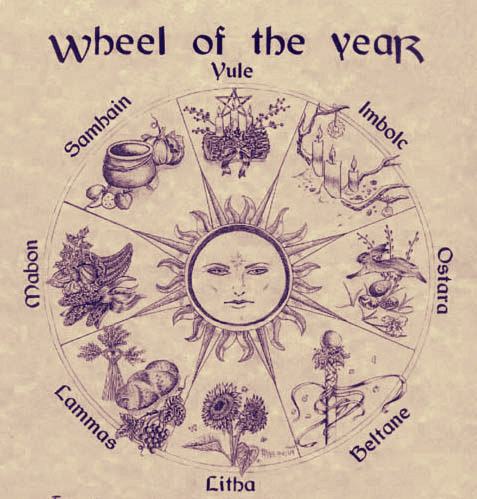
The Feasts of the Times
The Feasts of the Times correspond to the traditional 8 Sabbats:
3/21 Ostara - Spring Equinox
4/31 Beltane Fire Festival
6/21 Litha – Summer Solstice
8/01 Lammas Fire Festival
9/21 Mabon – Fall Equinox
10/31 Samhain Fire Festival
12/21 Yule – Winter Solstice
2/02 Imbolc Fire Festival
Greater Sabbats: Imbolc, Beltane, Lughnasadh, Samhain
Lesser Sabbats: Ostara, Litha, Modron, Yule
Ostara is also called Eostra, Eostre, Eastur, and Easter. It was originally celebrated on March 21st or thereabouts, when the Sun entered the Sign of Aries on the Spring or Vernal Equinox. Ostara is a Lesser Sabbat Day, and marks the height of Season of Spring, which started on Imbolc. However in modern times, this date is now used to mark the beginning of Spring. Ostara is celebrated in the Ophidian tradition as the Equinox of the Gods, which starts the High Holy Days.
Beltane is also called Floralia, May Day and Walpurgis Night. It was originally celebrated on April 31st or thereabouts. Beltane is a Greater Sabbat Day, and marks the beginning of Summer, which reaches its height on Litha at the Summer Solstice. Beltane is one of the four Fire Festivals that marked the Celtic calendar.
Litha is also called Midsummer. It was originally celebrated on June 21st or thereabouts, when the Sun entered the Sign of Cancer on the Summer Solstice. Litha is a Lesser Sabbat Day, and marks the height of Season of Summer, which started on Beltane. However in modern times, this date is now used to mark the beginning of Summer.
Lammas is also called Lughnasadh (Loo'-nahs-eh) and August Eve. It was originally celebrated on August 1st or thereabouts. Lammas is a Greater Sabbat Day, and marks the beginning of Fall, which reaches its height on Mabon at the Fall Equinox. Lammas is one of the four Fire Festivals that marked the Celtic calendar, and one of the three Wiccan harvest festivals which include Mabon and Samahin.
Mabon is also called Modron, Harvest Home. It was originally celebrated on September 21st or thereabouts, when the Sun entered the Sign of Libra on the Fall or Autumnal Equinox. Mabon is a Lesser Sabbat Day, and marks the height of Season of Autumn, which started on Lammas. However in modern times, this date is now used to mark the beginning of Fall. Mabon is also one of the three Wiccan Harvest Festivals, which include Lammas and Samhain.
Samhain is also called All Saints Day, All Hollow's 'een Halloween, and All Hollows Eve. It was originally celebrated on October 31st or thereabouts. Samhain is a Greater Sabbat Day, and marks the beginning of Winter, which reaches its height on Yule at the Winter Solstice. Samhain is one of the four Fire Festivals that marked the Celtic calendar, and one of the three Wiccan harvest festivals which include Mabon and Lammas.
Yule is also called Midwinter. It was originally celebrated on December 21st or thereabouts, when the Sun entered the Sign of Capricorn on the Winter Solstice. Yule is a Lesser Sabbat Day, and marks the height of Season of Winter, which started on Samhain. However in modern times, this date is now used to mark the beginning of Winter.
Imbolc is also called Candlemass. It was originally celebrated on February 2nd or thereabouts. Imbolc is a Greater Sabbat Day, and marks the beginning of Spring, which reaches its height on Ostara at the Spring Equinox. Imbolc is one of the four Fire Festivals that marked the Celtic calendar.

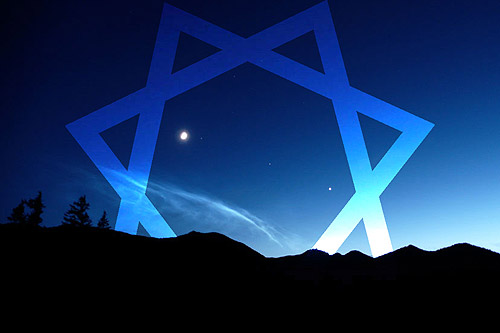
The Feast of the Evening Star
On any or every Friday evening, a Feast is held in honor of the Evening Star Venus, Hesperos or Vesper in Greek and Latin. This Feast and celebration can be a semi-public event for Shrines, which allows people from the outside to visit and socialize with Shrine members. The Venusian aspects of Babalon are celebrated on this night, poetry, art, music and all things of beauty and seduction. The attendants should dress in fine clothing, wear rich jewels, drink wines that foam and eat rich and luxurious foods. Invocations and rituals are optional, and such will be posted in the near future, but at the very least the Invocation of Venus should be read aloud and a toast to the Evening Star given.
Venus Invocation
(Taken with kind permission from Mystery Babalon: The Bhaktic and Ecstatic Rites of Babalon)
O Venus, who with a glance and a smile
can inspire the world by desire to heights undreamed of
in times forgotten.
Venus, your grip holds fast the world,
for all seek to attract your soft gaze
and win their bounty of love.
For do you not inspire all that is beautiful,
all that is graceful,
all that is joyful,
O Venus?
Indeed, and from beauty comes truth
and from grace comes the balance of justice
and from joy comes fulfillment.
And it is these virtues of love which inspire the best of us
to selfless acts of kindness and compassion,
which seek in their ends nothing in return.
There lies the secret within love which heals;
both the self and the other.
There lies the secret within love
which washes away the dross from the soul
and lightens the footsteps.
Come, O Venus, soft-footed, passionate and dancing!
Come, O Venus, lusty and desirous and wet!
Come, O Venus, bounty-laden, sweat-smelling,
full of hopes and promises.
Come, O Venus, with your love and beauty,
your harmonious grace, and your passionate desires.
Fill us wholly with your Divine Creativity,
and lend your inspiration and truth to the work at hand.
